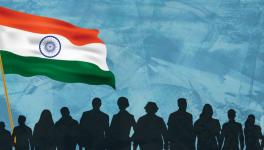India's Press Freedom Rank Drops to 161 in World Press Freedom Index

Cartoon by Irfan
New Delhi: India has slipped to 161st rank in terms of press freedom out of 180 countries ranked, according to the World Press Freedom Index published by Reporters Without Borders. This is a further drop from its 150th spot in 2022. India is now behind Pakistan (150) and Afghanistan (152) regarding press freedom rankings. Countries ranked lower than India include Bangladesh (163), Turkey (165), Saudi Arabia (170), and Iran (177). China and North Korea occupy the last spots at 179 and 180, respectively. The report was released on May 3, which is also World Press Freedom Day.
India's ranking is based on a country's performance in five broad categories: political context, legal framework, economic context, sociocultural context, and safety of journalists. Of the five, India's ranking was lowest in the safety of journalists category (172) and best in the social indicator category (143). The concentration of ownership is one of the significant concerns highlighted by the report. The abundance of media outlets conceals tendencies towards the concentration of ownership, with only a handful of sprawling media companies at the national level. The concentration is even more marked at the regional level for local language publications. This concentration of ownership in the print media can also be observed in the TV sector with major TV networks. The state-owned All India Radio (AIR) network owns all-news radio stations.
“…the abundance of media outlets conceals tendencies toward the concentration of ownership, with only a handful of sprawling media companies at the national level, including the Times Group, HT Media Ltd, The Hindu Group and Network18. Four dailies share three quarters of the readership in Hindi, the country’s leading language. The concentration is even more marked at the regional level for local language publications such as Kolkata’s Bengali-language Anandabazar Patrika, the Mumbai-based daily Lokmat, published in Marathi, and Malayala Manorama, distributed in southern India. This concentration of ownership in the print media can also be observed in the TV sector with major TV networks such as NDTV. The state-owned All India Radio (AIR) network owns all news radio stations,” the report stated.
“The violence against journalists, the politically partisan media and the concentration of media ownership all demonstrate that press freedom is in crisis in ‘the world’s largest democracy’, ruled since 2014 by Prime Minister Narendra Modi, the leader of the Bharatiya Janata Party (BJP) and the embodiment of the Hindu nationalist right,” the report said.
“Originally a product of the anti-colonial movement, the Indian press used to be seen as fairly progressive but things changed radically in the mid-2010s when Narendra Modi became prime minister and engineered a spectacular rapprochement between his party, the BJP, and the big families dominating the media. The prime example is undoubtedly the Reliance Industries group led by Mukesh Ambani, now a personal friend of Modi’s, who owns more than 70 media outlets that are followed by at least 800 million Indians. Similarly, the takeover of the NDTV channel at the end of 2022 by tycoon Gautam Adani, who is also very close to Narendra Modi, signalled the end of pluralism in the mainstream media. Very early on, Modi took a critical stance vis-à-vis journalists, seeing them as “intermediaries” polluting the direct relationship between himself and his supporters. Indian journalists who are too critical of the government are subjected to all-out harassment and attack campaigns by Modi devotees known as bhakts,” the report added.
The report also highlights that Indian law is protective in theory. Still, charges of defamation, sedition, contempt of court, and endangering national security are increasingly used against journalists critical of the government, who are branded as "anti-national." There is a lack of diversity in Indian newsrooms, according to RSF. “Mostly, only Hindu men from upper castes hold senior positions in journalism or are media executives – a bias reflected in media content. For example, fewer than 15% of the participants in significant evening talk shows are women,” the report mentioned. RSF notes that “India averages three or four journalists killed in connection with their work every year, making it one of the world's most dangerous countries for journalists.”
In February last year, the union government said it does not agree with the views and country rankings listed in the World Press Freedom Index since a "foreign" NGO published it.
Get the latest reports & analysis with people's perspective on Protests, movements & deep analytical videos, discussions of the current affairs in your Telegram app. Subscribe to NewsClick's Telegram channel & get Real-Time updates on stories, as they get published on our website.
























